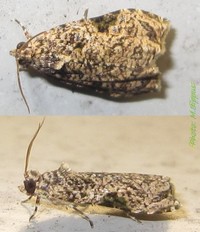Eccopsis praecedens is a moth of the family Tortricidae. It is found in western, central, eastern and southern Africa, including the islands of São Tomé, Cape Verde, Madagascar and Réunion.[6]
| Eccopsis praecedens | |
|---|---|

| |
| Scientific classification | |
| Domain: | Eukaryota |
| Kingdom: | Animalia |
| Phylum: | Arthropoda |
| Class: | Insecta |
| Order: | Lepidoptera |
| Family: | Tortricidae |
| Genus: | Eccopsis |
| Species: | E. praecedens
|
| Binomial name | |
| Eccopsis praecedens Walsingham, 1897[1]
| |
| Synonyms[4][5] | |
Larvae of this species had been stated on Cassia fistula (Fabaceae).[7]
References
edit- ^ Walsingham, [Thomas de Grey] (1897). "Western Equatorial African Micro-Lepidoptera". Transactions of the Entomological Society of London. 1897 (1): 56–57. doi:10.1111/j.1365-2311.1897.tb01674.x; Pl. 3, Fig. 21.
- ^ Diakonoff, Alexis (1983). "Tortricidae from the Comoro Islands (Lepidoptera)". Annales de la Société Entomologique de France. Nouvelle Série. 19 (1): 67–68; Pl. 8, Fig. 19–20.
- ^ Guillermet, Christian (2006). "Contribution à l'étude des Hétérocères de l'île de La Réunion Description de nouvelles espèces de Tortricidae Olethreutinae Cryptophlebia colasi, C. destrumeli et C. gaetani et sept Hétérocères de première citation" (PDF). L'Entomologiste. 62 (3–4): 70–71.
- ^ Aarvik, Leif (2004). "Revision of the subtribe Neopotamiae (Lepidoptera: Tortricidae) in Africa" (PDF). Norwegian Journal of Entomology. 51 (1): 78–80.
- ^ Timm, A. E.; Brown, J. W. (2014). "Two new combinations in Thaumatotibia Zacher (Lepidoptera: Tortricidae) from Réunion Island, with an updated list of the Afrotropical species". Short communications. African Entomology. 22 (3): 678. doi:10.4001/003.022.0321. hdl:10520/EJC160230.
- ^ De Prins, J.; De Prins, W. (2017). "Eccopsis praecedens Walsingham, 1897". Afromoths. Retrieved November 15, 2017.
- ^ Martiré, Dominique; Rochat, Jacques (2008). Les papillons de La Réunion et leurs chenilles. Mèze: Biotope. p. 313. ISBN 978-2-85653-621-6.
Further reading
edit- Diakonoff, Alexis (1981). "Tortricidae from Madagascar Part 2. Olethreutinae, 1". Annales de la Société Entomologique de France. Nouvelle Série. 17 (1): 12–14; fig 4, 7–9.
{{cite journal}}: CS1 maint: postscript (link)
External links
edit